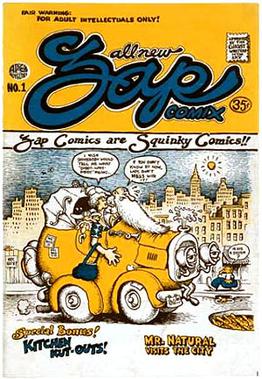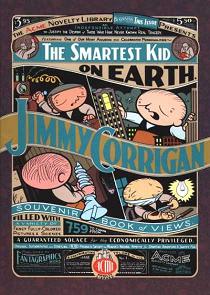Related Research Articles

Underground comix are small press or self-published comic books that are often socially relevant or satirical in nature. They differ from mainstream comics in depicting content forbidden to mainstream publications by the Comics Code Authority, including explicit drug use, sexuality, and violence. They were most popular in the United States in the late 1960s and 1970s, and in the United Kingdom in the 1970s.

Gilberto Hernández, usually credited as Gilbert Hernandez and also by the nickname Beto, is an American cartoonist. He is best known for his Palomar/Heartbreak Soup stories in Love and Rockets, an alternative comic book he shared with his brothers Jaime and Mario.

Acme Novelty Library is a comic book series created by Chicago cartoonist Chris Ware. Its first issue appeared in 1993. Published from 1994 by Fantagraphics Books and later self-published, it is considered a significant work in alternative comics, selling over 20,000 copies per issue.

Kim Deitch is an American cartoonist who was an important figure in the underground comix movement of the 1960s, remaining active in the decades that followed with a variety of books and comics, sometimes using the pseudonym Fowlton Means.

Franklin Christenson "Chris" Ware is an American cartoonist known for his Acme Novelty Library series and the graphic novels Jimmy Corrigan, the Smartest Kid on Earth (2000), Building Stories (2012) and Rusty Brown (2019). His works explore themes of social isolation, emotional torment and depression. He tends to use a vivid color palette and realistic, meticulous detail. His lettering and images are often elaborate and sometimes evoke the ragtime era or another early 20th-century American design style.

Daniel Gillespie Clowes is an American cartoonist, graphic novelist, illustrator, and screenwriter. Most of Clowes's work first appeared in Eightball, a solo anthology comic book series. An Eightball issue typically contained several short pieces and a chapter of a longer narrative that was later collected and published as a graphic novel, such as Like a Velvet Glove Cast in Iron (1993), Ghost World (1997), David Boring (2000) and Patience (2016). Clowes's illustrations have appeared in The New Yorker, Newsweek, Vogue, The Village Voice, and elsewhere. With filmmaker Terry Zwigoff, Clowes adapted Ghost World into a 2001 film and another Eightball story into the 2006 film, Art School Confidential. Clowes's comics, graphic novels, and films have received numerous awards, including a Pen Award for Outstanding Work in Graphic Literature, over a dozen Harvey and Eisner Awards, and an Academy Award nomination.

Charles Burns is an American cartoonist and illustrator. His early work was published in a Sub Pop fanzine, and he achieved prominence in the early issues of RAW. His graphic novel Black Hole won the Harvey Award.

Raw was a comics anthology edited by Art Spiegelman and Françoise Mouly and published in the United States by Mouly from 1980 to 1991. It was a flagship publication of the 1980s alternative comics movement, serving as a more intellectual counterpoint to Robert Crumb's visceral Weirdo, which followed squarely in the underground tradition of Zap and Arcade. Along with the more genre-oriented Heavy Metal it was also one of the main venues for European comics in the United States in its day.

Pantheon Books is an American book publishing imprint with editorial independence. It is part of the Knopf Doubleday Publishing Group.

Zongo Comics was a comic book publisher. It was founded and published in 1995 by Simpsons and Futurama creator Matt Groening. Unlike its counterpart Bongo Comics, the comics published were geared towards grown-up audiences containing adult material and did not include any adaptations of Groening's cartoons. The only two titles in the Zongo Comics range were Gary Panter's Jimbo and Mary Fleener's Fleener.

Françoise Mouly is a French-born American designer, editor and publisher. She is best known as co-founder, co-editor, and publisher of the comics and graphics magazine Raw (1980–1991), as the publisher of Raw Books and Toon Books, and since 1993 as the art editor of The New Yorker. Mouly is married to cartoonist Art Spiegelman, and is the mother of writer Nadja Spiegelman.
Jack Edward Jackson, better known by his pen name Jaxon, was an American cartoonist, illustrator, historian, and writer. He co-founded Rip Off Press, and some consider him to be the first underground comix artist, due to his most well-known comic strip God Nose.

Dash Shaw is an American comic book writer/artist and animator. He is the author of the graphic novels Cosplayers, Doctors, New School, and Bottomless Belly Button, published by Fantagraphics. Additionally, Shaw has written Love Eats Brains published by Odd God Press, GardenHead published by Meathaus, The Mother's Mouth published by Alternative Comics, and BodyWorld published by Pantheon Books.
Jimbo's Inferno is a 2006 graphic novel created by Gary Panter and published by Fantagraphics Books.
The Rozz Tox Manifesto is a 1979 essay by visual artist Gary Panter in which Panter rejects the notion of the artist as bohemian; instead, an artist is encouraged to work within capitalism to reach a larger market.
David Heatley is an American cartoonist, illustrator, graphic designer, and musician.

The Narrative Corpse is a chain story, or comic jam, created by 69 all-star cartoonists in the early-to-mid 1990s. A graphic novel compilation of the result was published in 1995.
Paul Karasik is an American cartoonist, editor, and teacher, notable for his contributions to such works as City of Glass: The Graphic Novel, The Ride Together: A Memoir of Autism in the Family, and Turn Loose Our Death Rays and Kill Them All!. He is the coauthor, with Mark Newgarden, of How to Read Nancy, 2018 winner of the Eisner Award for "Best Comics-Related Book". His work has appeared in The New York Times, The Washington Post and he is also an occasional cartoonist for The New Yorker.
Raw Books & Graphics is an American publishing company specializing in comics and graphic novels. Operating since 1978, it is owned and operated by Françoise Mouly. The company first came to prominence publishing Raw magazine, co-edited by Mouly and her husband, cartoonist Art Spiegelman. In the 1980s the company published graphic novels, and with the formation of Raw Junior in 1999, branched into children's comics with Little Lit and Toon Books.

Ben Passmore is an American comics artist and political cartoonist.
References
Citations
- ↑ Jimbo: Adventures in Paradise. Pantheon Books. 1988.
- ↑ "Inkpot Awards". San Diego Comic-Con International. Retrieved June 3, 2024.
- ↑ Seneca, Matt (October 24, 2011). "IN THE LAND UNKNOWN WITH GARY PANTER". FEATURES. The Comics Journal.
- ↑ "Daytime Emmy Awards". IMDB.com. Retrieved June 3, 2024.
2 WINS & 3 NOMINATIONS
- ↑ "Firecracker Alternative Book Awards". ReadersRead.com. Archived from the original on March 4, 2009.
- 1 2 "Bio". Jimbo: Adventures in Paradise. Pantheon Books. 1988.
- ↑ AGRESTA, MICHAEL (January 2, 2018). "HIS PET MONSTERS". The Texas Observer .
Panter and his wild college cohort became known as the Lizard Cult...
- 1 2 3 4 Jennings, Dana (July 21, 2017). "When a Comic Book Hillbilly and Milton Collide". The New York Times.
- ↑ Matt Groening On Gary Panter, May 27th, Los Angeles. Dan Nadel. June 13, 2008. Archived from the original on December 13, 2021. Retrieved October 23, 2021– via YouTube.
- 1 2 Park, Ed (April 5, 2021). "Gary Panter's Jagged, Shape-Shifting Antihero Was Made for Our Moment". GRAPHIC CONTENT. The New York Times.
- ↑ "'JIMBO' GETS AMERICAN BOOK AWARD". ICv2 . October 30, 2007.
- ↑ "Gary Panter". Lambiek .
- ↑ Panter, Gary. "The Rozz-Tox Manifesto". New West Magazine – via RozzTox.com.
- ↑ "The Wrong Box". United Dead Artists. Archived from the original on February 20, 2015.
- ↑ "The Land Unknown". United Dead Artists. Archived from the original on February 20, 2015.
- ↑ Pouncy, Edwin (2003). "Gary Panter interview". GaryPanter.com. Archived from the original on October 28, 2008.
- ↑ Chris Bors (May 8, 2008). "Gary Panter in New York". ARTINFO. Retrieved May 14, 2008.
- ↑ "Exhibitions: Masters of American Comics". The Jewish Museum. Archived from the original on May 11, 2011. Retrieved 2010-08-10.. .
- ↑ Kimmelman, Michael (October 13, 2006). "See You in the Funny Papers (art review)". The New York Times .
- ↑ "Interview with avant-garde artist Gary Panter -- one of the first New Wave cartoonists in the 1970s". Blues.gr. Interviewed by Michael Limnio. June 17, 2015. Retrieved October 23, 2021.